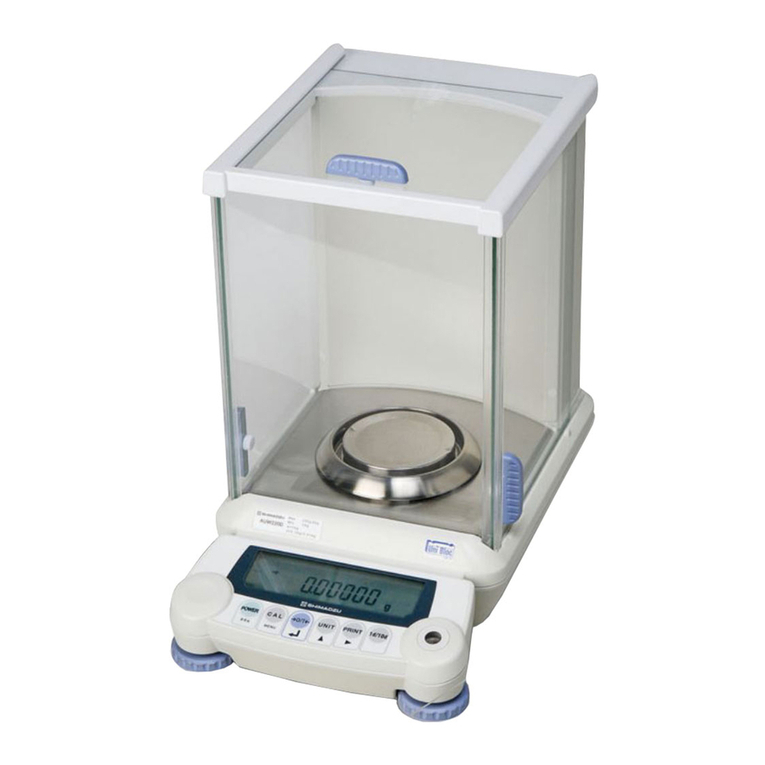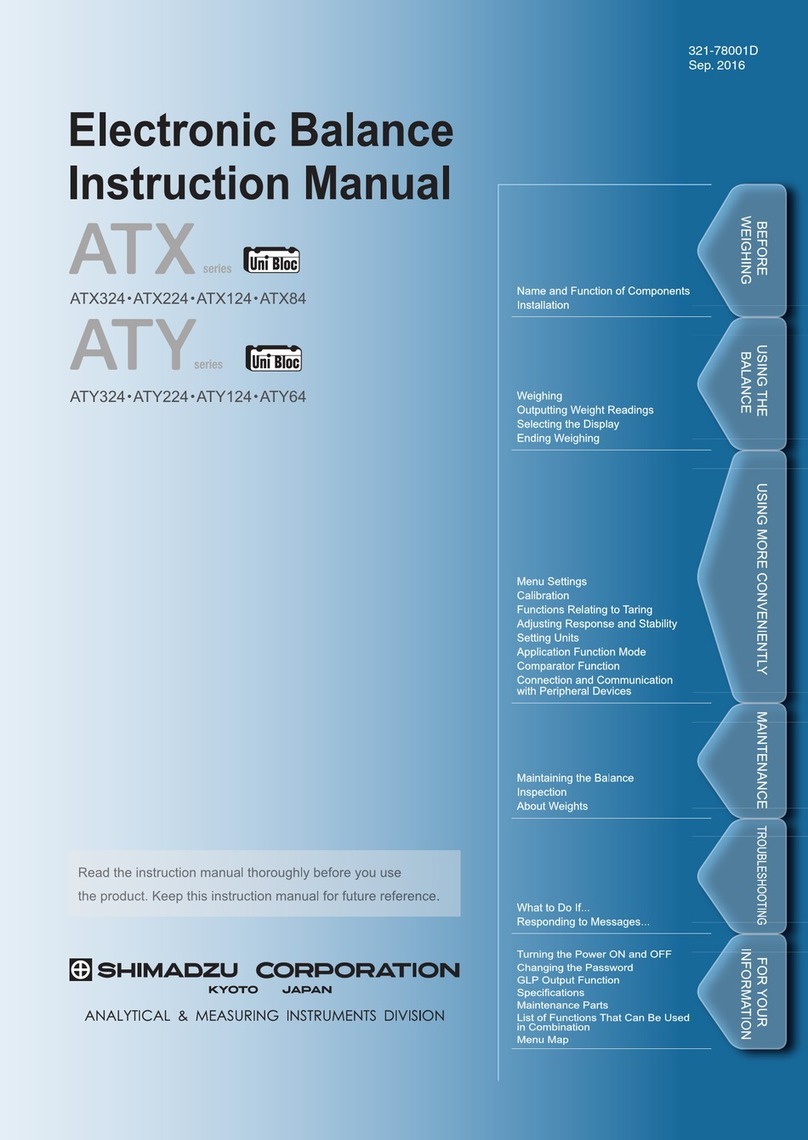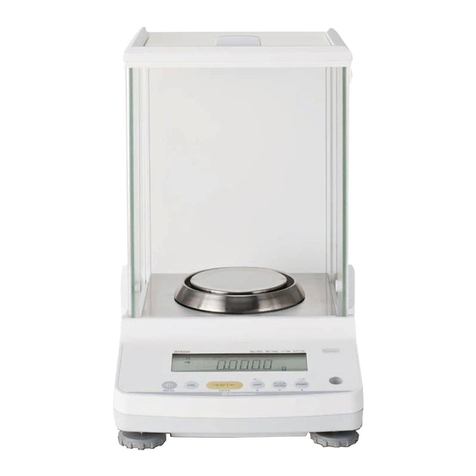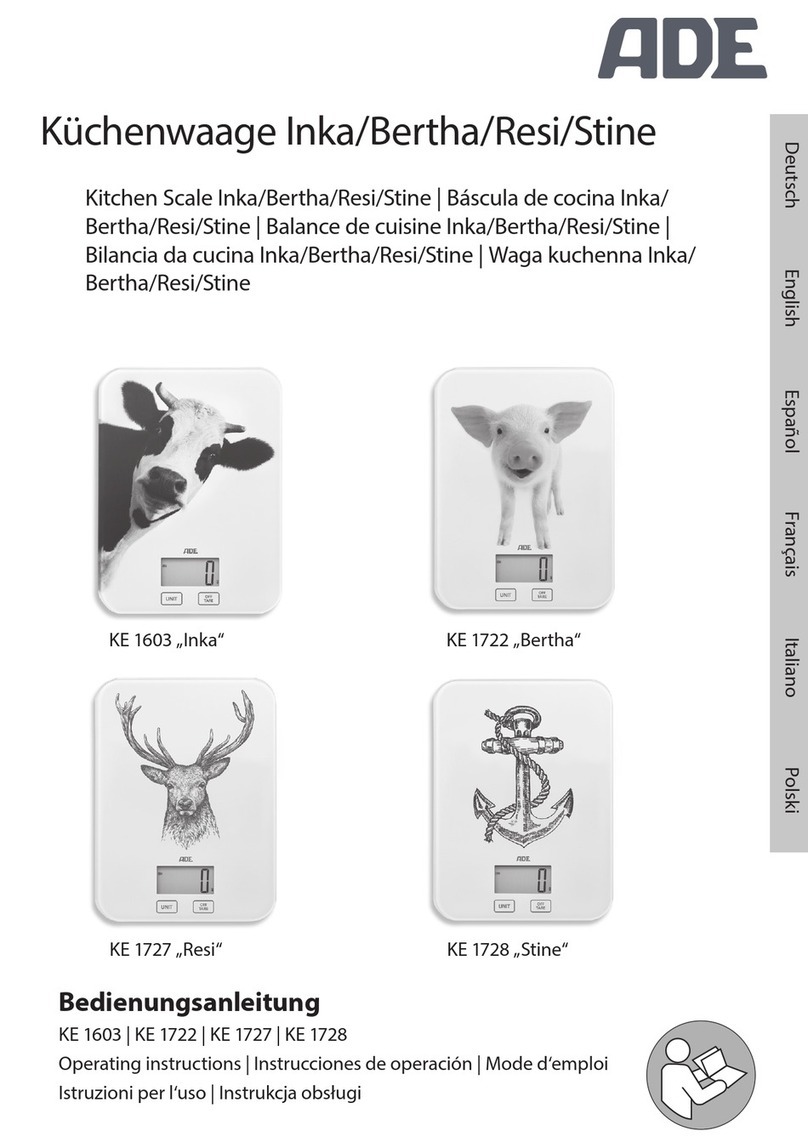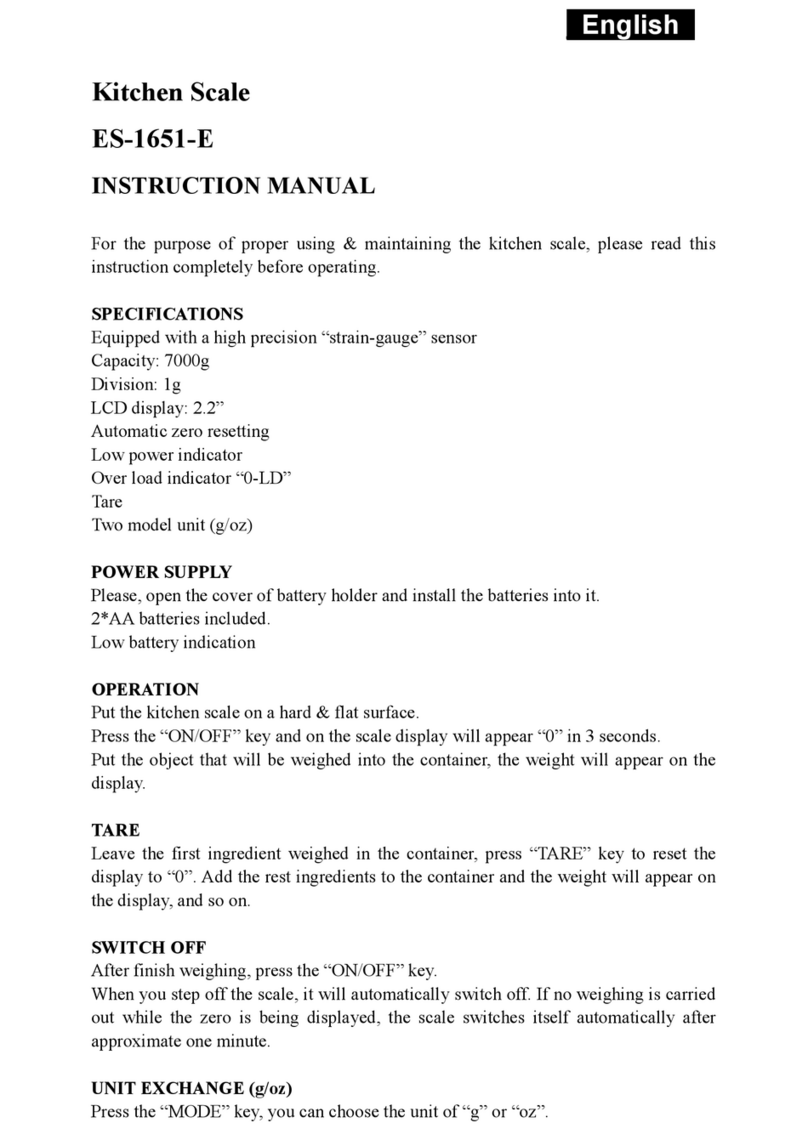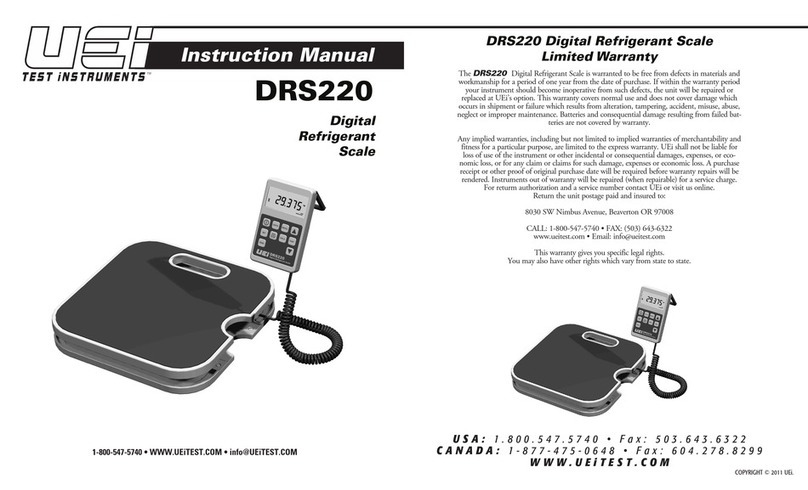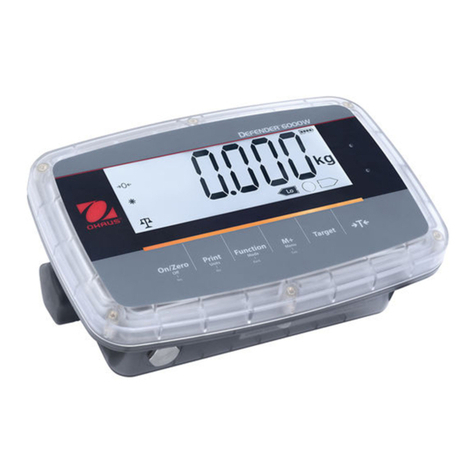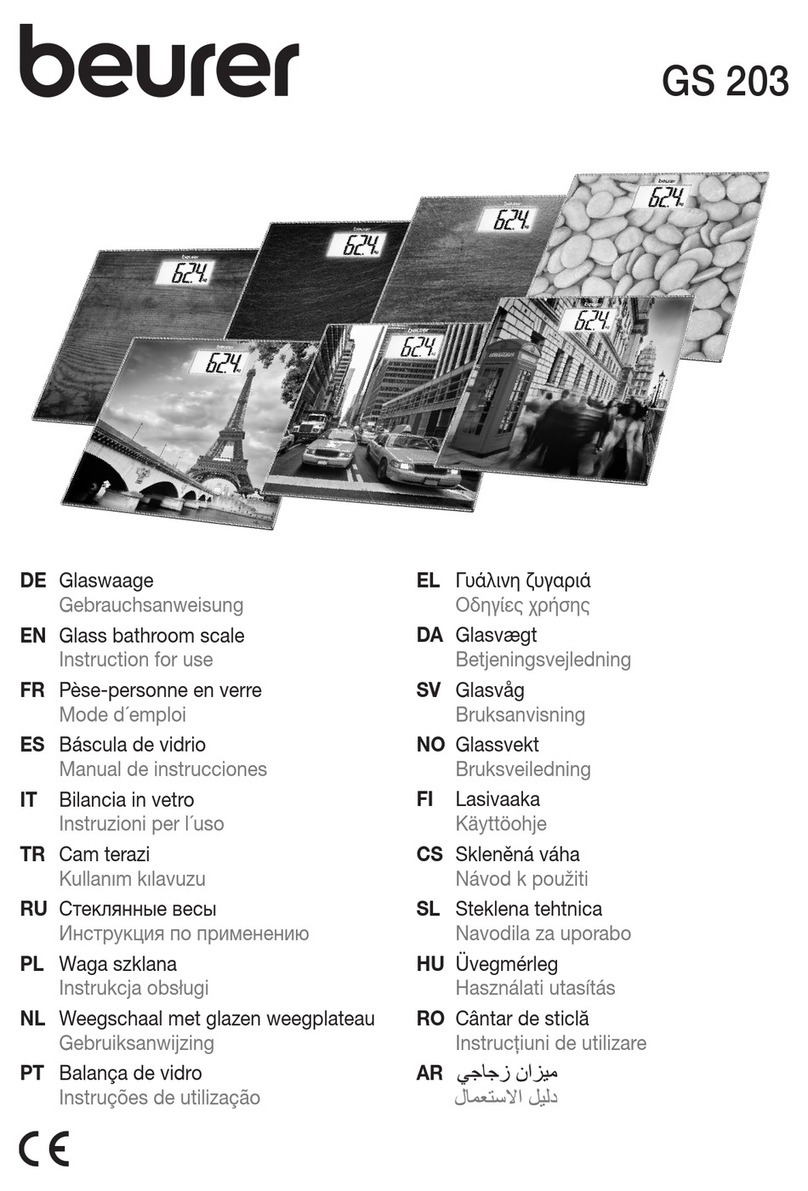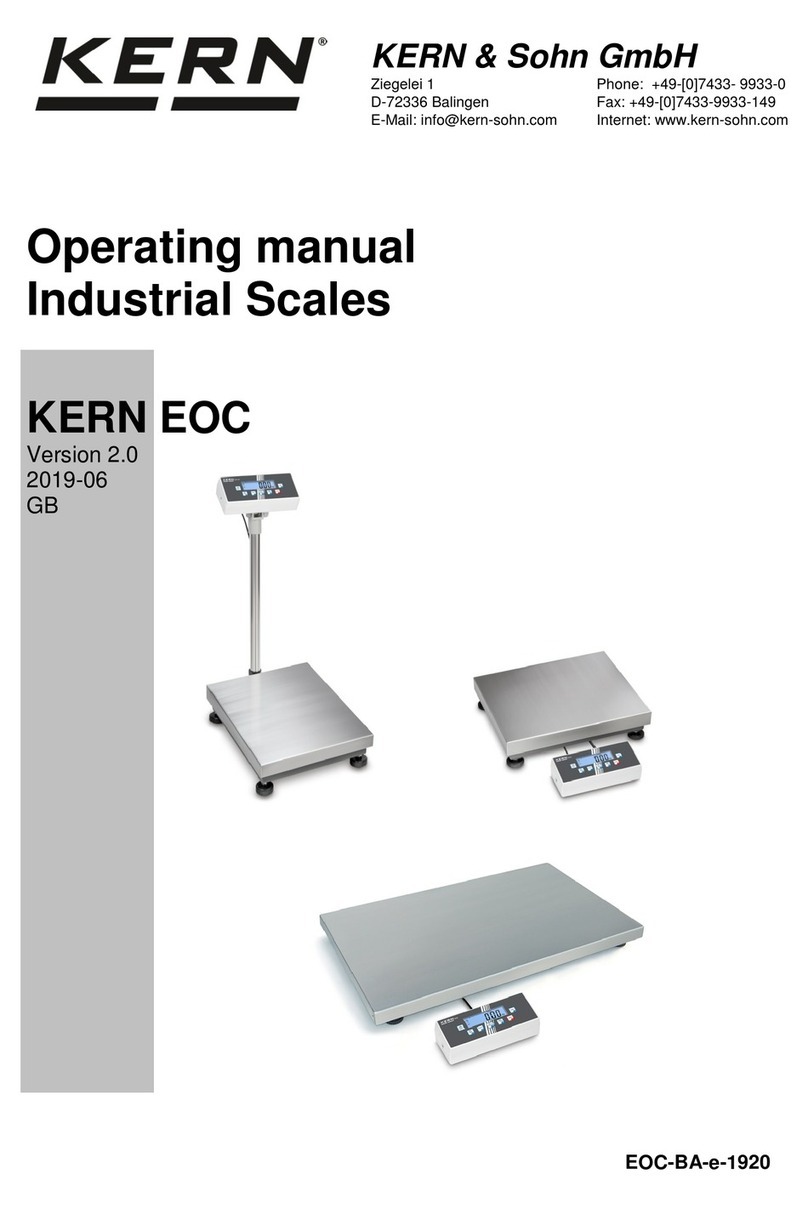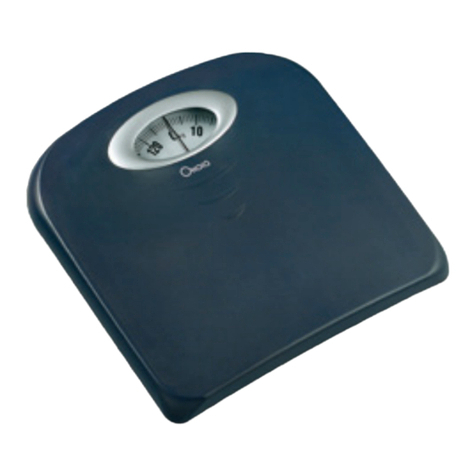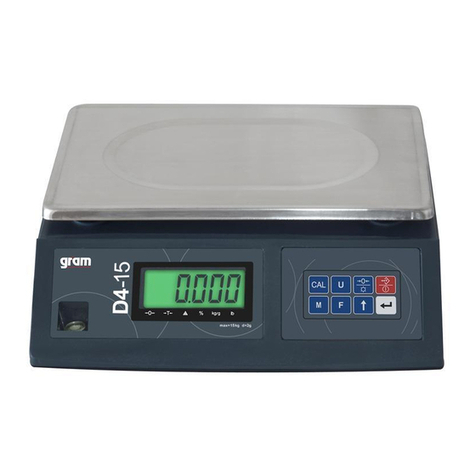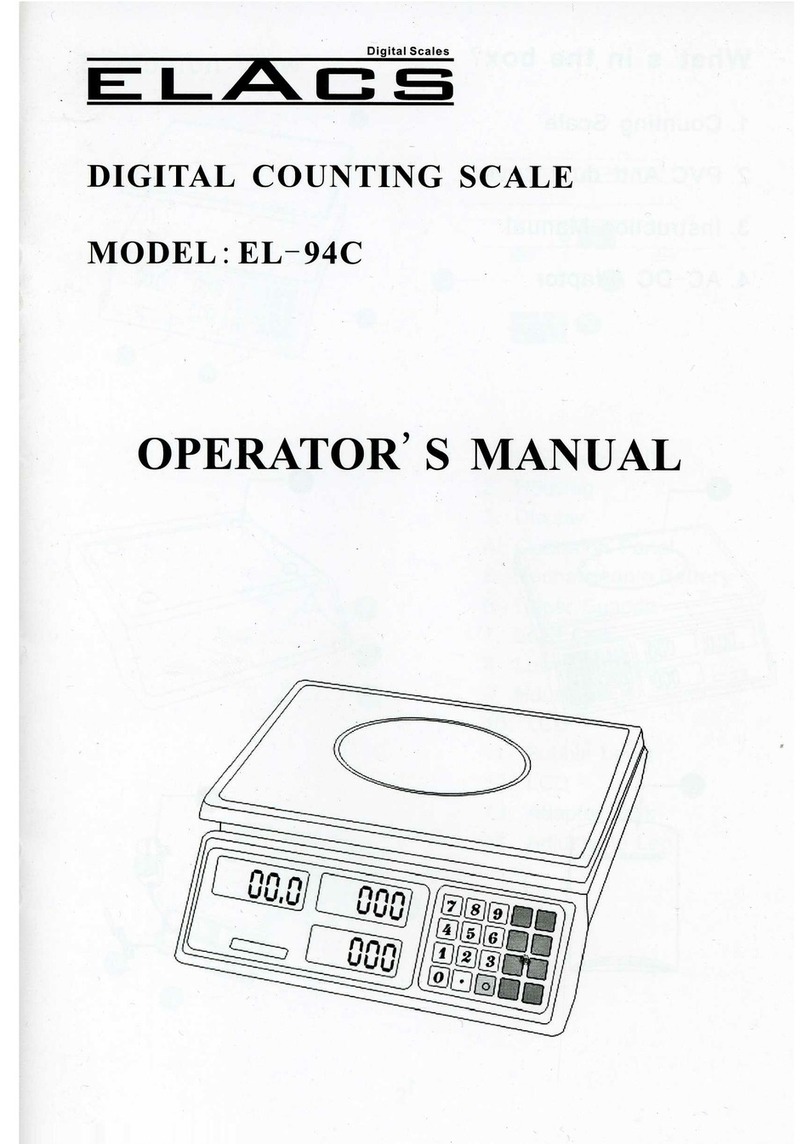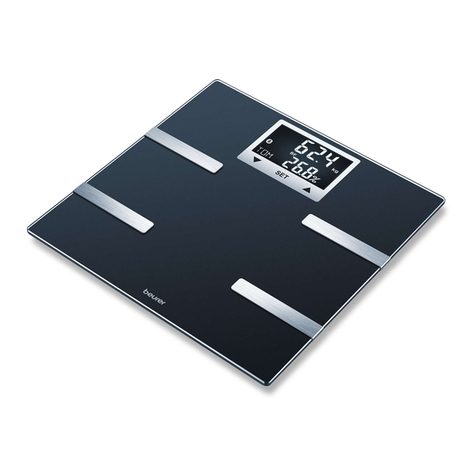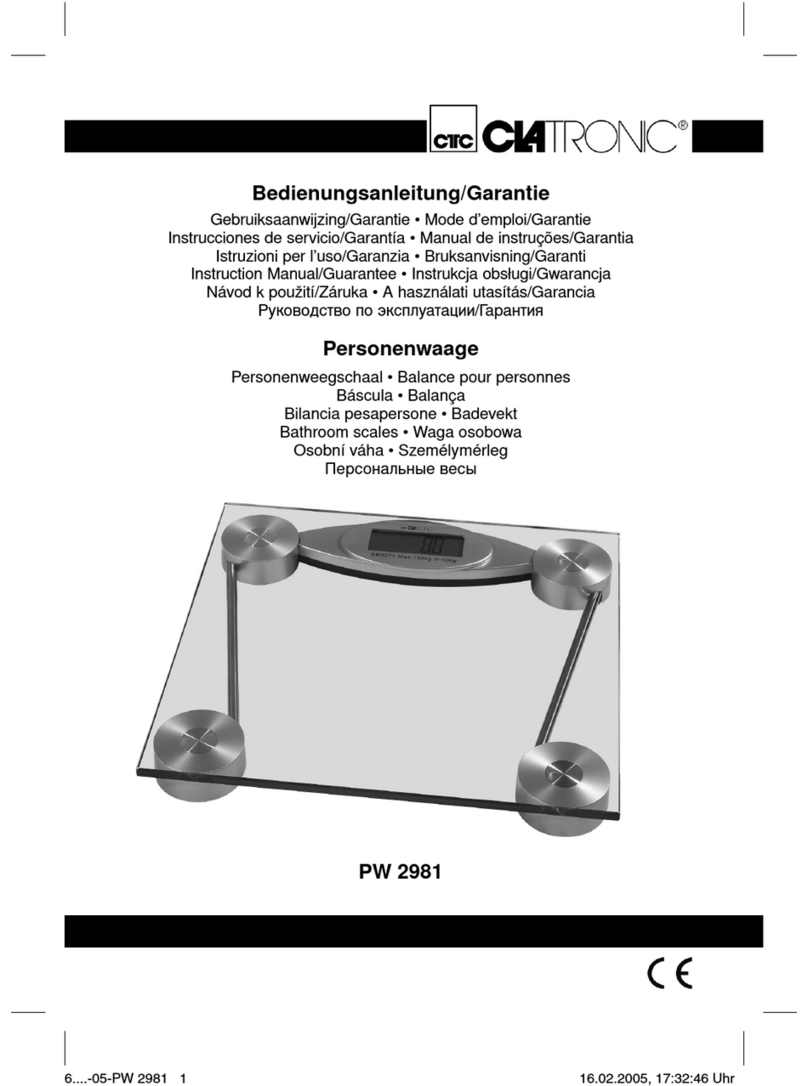Shimadzu BL3200H User manual

ELECTRONIC BALANCE
BL SERIES
BL320S(L), BL620S(L),
BL3200S(L), BL220H(L),
BL320H(L), BL2200H(L),
BL3200H(L)
INSTRUCTION MANUAL
M054-E089I


ELECTRONIC BALANCE
BL SERIES
BL320S(L), BL620S(L),
BL3200S(L), BL220H(L),
BL320H(L), BL2200H(L),
BL3200H(L)
INSTRUCTION MANUAL
READ AND UNDERSTAND THIS MANUAL BEFORE
OPERATION. SAVE THIS MANUAL.

Safety Precautions
MEANING OF CAUTION SIGNS
Indicates a potentially hazardous situation which,
if not avoided, may result in minor or moderate
injury, or may result in machine damage.
is used to emphasize essential information.
Do not use the BL series in a bad atmosphere
such as inflammable gas, liquid, dust, etc.
Use only the AC adapter that supplys the output of
12VDC or the AC adapter provided by the distributor
who is authorized by Shimadzu Corporation.
Use options and peripheral devices prepared by
Shimadzu. If the devices other than designated ones are
used, the balance may not function correctly.
The BL series is a precise instrument. To use the
balance for a long period, treat it carefully.
CAUTION
CAUTION
NOTICE

INTRODUCTION
Thank you for purchasing Shimadzu Electronic Balance BL series. To use this
balance for a long period of time, be sure to read this manual before operating the
balance and keep this securely for later use.


CONTENTS
1. COMPONENTS AND THEIR NAMES..................................................... 1
2. INSTALLATION......................................................................................... 3
3. WARM-UP.................................................................................................. 4
4. CAUTION NOTES ..................................................................................... 5
5. MESURING PROCEDURE ....................................................................... 5
6. MENU SELECTION .................................................................................. 6
6.1 Menu selection when “ ” is selected ............................... 8
6.2 Menu selection when “ ” is selected ................................... 10
7. SENSITIVITY CALIBRATION ................................................................. 11
7.1 Setting the value of sensitivity calibration weight................................... 11
7.2 Sensitivity Calibration ............................................................................. 13
8. REGISTRATION, CANCEL, AND CHANGE OF UNIT.......................... 14
9. % SETTING................................................................................................ 15
10. PCS (No. of pieces) SETTING ................................................................... 16
11. PERFORMANCE CHECKS....................................................................... 17
12. MAINTENANCE........................................................................................ 18
13. TROUBLESHOOTING .............................................................................. 19
14. SPECIFICATIONS...................................................................................... 20
15. PARTS LIST................................................................................................ 21
16. PERIPHERAL DEVICES ........................................................................... 22
16.1 The EP-60A Electronic Printer ................................................................ 22
16.2 The IFB-102A RS-232C Interface........................................................... 23
16.3 Input/output Format................................................................................. 25
16.4 Command Code ....................................................................................... 26
17. Detailed Information on Unit Conversion................................................... 27


-1-
1. COMPONENTS AND THEIR NAMES
Components Included with every balance are one of the following items.
•Balance body •AC adapter (option) •protection cover
•Pan •Pan supporter •Instruction manual
•Inspection certificate •Breeze guard (Only type, BL220H (L) and
BL320H (L)).
○
1Balance body ○
2Pan ○
3Pan supporter
○
4Pan shaft ○
5Level gauge ○
6Power jack
○
7Level screws (3 places) ○
8Protection cover ○
9AC adapter (option)
○
10 Data I/O connector ○
11 Breeze guard (Only BL220H (L) and BL320H (L))
○
12 Breeze guard cover (Only BL220H (L) and BL320H (L))

-2-
Display and keypad
Display
Keypad

-3-
2. INSTALLATION
Check power
voltage
•Use only the AC adapter that supplys the output of 12VDC or the
AC adapter provided by the distributor who is authorized by
Shimadzu Corporation.
•Check the power supply voltage.
•Check that the supplied power voltage satisfies the displayed value
on the AC adaptor.
•In order to prevent electric shock when connecting the power, use
a 3P plug with a grounding line or a 2P plug after connecting the
grounding wire to the screw at the back of the case.
•Do not place anything that makes it difficult to pull the AC adapter
off the outlet.
Installation
site Avoid installing the balance in a place where:
•It is exposed to corrosive gas or flammable gas;
•It is exposed dust, wind, vibration, electromagnetic waves, or a
magnetic field;
•It is exposed to direct sunlight or a sudden change in temperature;
or
•It is exposed to extremely high or low temperature or humidity.
Installation (1) Remove the protection seals (4 places)
from the protection cover and then put
it on the balance body.
(2) Turn the level screw so that the air
bubble on the level gauge is positioned
at the center of the red circle. Make
sure that the balance never jolt.
For easy adjustment, insert the level
screw on the right back forcibly to the balance body. Then while
lightly pressing the balance top with your hand, adjust the horizontal
level with the level screws on the right front and left front.
Finally, in order to make the balance stable, adjust the right back
screw to touch the floor.
This procedure allows you to level the balance quickly.
CAUTION
CAUTION
CAUTION
CAUTION
CAUTION
CAUTION
NOTICE
NOTICE
NOTICE

-4-
(3) Place the pan supporter on the pan shaft
and then the pan on the pan supporter.
(4) Plug the AC adapter into the outlet.
The balance shows after
self-checking.
(5) Press the POWER/BRK key. All
displays light for one minute. Then
the display automatically shows "zero"
and the balance enters measurement
ready state.
(6) Press the POWER/BRK key again.
The standby mark lights up and the
balance enters standby state.
(7) Warm up the balance.
(8) Calibrate the sensitivity. Refer to “7. SENSITIVITY
CALIBRATION”.
(9) Check the performance. Refer to “11. PERFORMANCE
CHECKS”
3. WARM-UP
•Apply power in advance for one hour
or more. This will allow you to
immediately make an accurate
measurement.
•Even if the balance is not used, keep
the standby mark lit (warm-up state)
by pressing the POWER/BRK key without disconnecting
the AC adapter.
•If the balance is not used for one month or more, disconnect
the AC adapter.

-5-
4. CAUTION NOTES
Do not...... •put water, metal pin or any thing in the balance;
•open the balance case;
•leave anything exceeding the weighing capacity on the pan;
•expose the balance to anything magnetized;
•connect anything other than the specified equipment to the
connector on the rear side of the balance; and.
•give a shock to the pan.
5. MEASUREMENT PROCEDURE
Preparation Warm up the balance.
for Weighing
Press the POWER/BRK key. The
standby mark goes off and all displays
light. Check that there is no segment
which is not lit.
The balance shows zero and enters the
measurement mode
When using a tare, load the tare on the
pan and press the TARE key after a
stability mark is lit.
Check that the display shows zero.
Load a sample. When the stability mark is lit, read the display.
If the total mass of the sample and tare exceeds the weighing
capacity, oL will be displayed.
•Tare................................ A sample container or other.
•Stability mark (→)......... Lights when the displayed value falls within
the stability band. When the load change is
slow, the displayed value will flucutate with
the stability mark lit.
Making a
measure-
ment
mode
Measurement
(1)
(2)
(3)
(1)
(2)

-6-
6. MENU SELECTION
This balance is designed to permit selection of the measuring conditions to compensate
for vibration and other conditions present at the installation site. This feather permits greater
weighing efficiency and accuracy, and is referred to as “Menu Selection”.
Also in BL series, setting the balance to “ ” (standard measurement mode)
makes a normal measurement and requires no other setting.
The menu in the BL series consists of three classifications. Basically press the TARE key
to go to lower hierarchy, and press the POWER/BRK key to return to upper hierarchy.
Continuously pressing the POWER/BRK key returns the display to weight display from
each hierarchy with single operation.
Step (1) Press the CAL/MENU key during the weight display.
(2) “ ” will be displayed.
(3) Every time the CAL/MENU key is subsequently pressed, the
display be changed in the order shown below.
(4) Select the desired condition and press the TARE key. Then, it will
be set or enter into the lower hierarchy.

-7-
•If the measurement is done at severe measurement environment and the stability of the
display is not so good, set the balance to “ ” (high-stability mode).
•When the high-speed sample pouring mode is executed, or the small mount of sample
pouring is done, set the balance to “ ” (sample mode).

-8-
6.1 Menu selection when “ ” is selected
Pressing the TARE key when the “ ” is displayed at 1st hierarchy
menu enters 2nd hierarchy menu.
In this menu, ON/OFF of zero tracking, setting the stability detection band,
registration/cancel of unit, ON/OFF of auto print, and ON/OFF of analog display are made.
Key operation and each setting are made as follows.
tl
tl
tl
Ib Lb (pound)
Taiwan tael*
Taiwan tael*
Taiwan tael*
none
none
none
Sawaran*
Kyats*
Custom*

-9-
(→) : Press the TARE key.
(←) : Press the POWER/BRK key.
(↓) : Press the CAL/MENU key.
•When set to , satisfactory for most use, the stability mark lights when the display
stays within +/-1 unit (the resolution value of the balance) for a fixed period time.
•When the display shows “ :**, *, :
**,: :
**”, the
currently set conditions are displayed on **.
•Zero tracking eliminates zero drift, and should be on ( ) for normal
weighing. When measuring weight changes over time, or when slowly adding a liquid or
powder to the balance, turn off ( ) the zero tracking feature.
* It can be selected in special Area only.

-10-
6.2 Menu display when is selected
Pressing the TARE key when the “ ” is displayed at 1st hierarchy
menu enters 2nd hierarchy menu.
In this menu, the input/output format can be set.
(→) : Press the TARE key.
(←) : Press the POWER/BRK key.
(↓) : Press the CAL/MENU key.
•When the display shows “ :**, :
**, :
**, :
**”, the currently set
conditions are displayed on **.

-11-
7. SENSITIVITY CALIBRATION
The electronic balance measures mass by electronicity compensating for terrestrial
gravitation. Since gravitation varies slightly in different regions, span calibration (sensitivity
calibration) is required when the balance is installed. Temperature also effects balance
accuracy, and calibration must be performed whenever a significant change occurs. It is
good practice to calibrate the balance whenever the balance is moved or unexpected shock
is applied to the balance such that an article drops on the pan.
7.1 Setting the value of sensitivity calibration weight
In this balance, the value for sensitivity calibration weight can be set freely within the
specified range. Using the weight having known value, sensitivity calibration can be made.
Set the weight value using at sensitivity calibration as follows.
Step (1) Following the menu selection, press the
CAL/MENU key to make the display
“ ”.
(2) Press the TARE key to set the
balance to weight set mode.
(3) The weight value currently set is
displayed and the digit to be set blinks.
When the weight value is not changed,
press the TARE key.
(4) Pressing the PRINT key shifts the
blinking digit.
(5) Pressing the UNIT key counts up
the blinking displayed value.
(6) Repeats the steps (4) and (5) to set the
weight value.
(7) When aborting the setting, press the
POWER/BRKkey.Then“ ”
is displayed for several seconds, the
balance stops the setting of weight
value and returns to weight display.

-12-
(8) After the setting of weight value is completed, press the TARE
key.
(9) “ ” is displayed for several seconds and the balance returns to
weight display.
(10) When setting the weight value exceeding the specified range,
“ ” is displayed and then the balance returns to weight
display.
The settable weight value is follows.
BL320S (L) More than 150g and less than
weighing capacity BL320H (L) More than 150g and less than
weighing capacity
BL620S (L) More than 300g and less than
weighing capacity BL2200H (L) More than 1000g and less than
weighing capacity
BL3200S (L) More than 1500g and less than
weighing capacity BL3200H (L) More than 1500g and less than
weighing capacity
BL220H (L) More than 100g and less than
weighing capacity
This manual suits for next models
18
Table of contents
Other Shimadzu Scale manuals
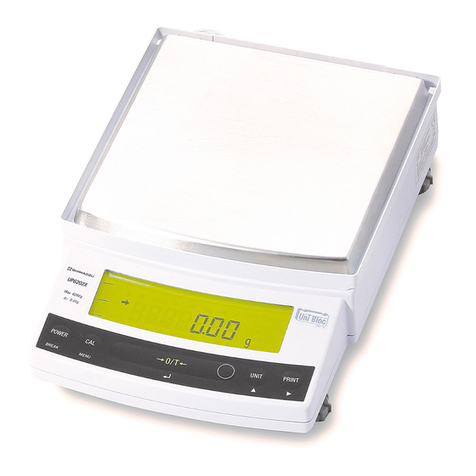
Shimadzu
Shimadzu UPX Series User manual
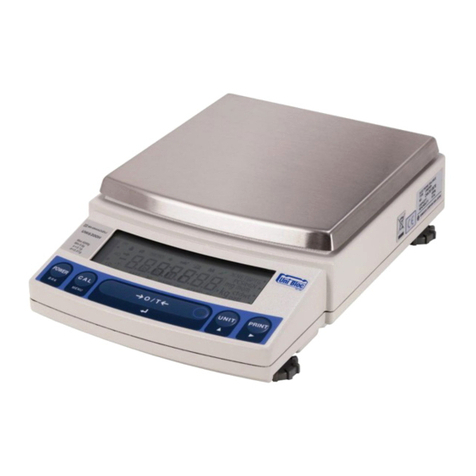
Shimadzu
Shimadzu UW220H User manual
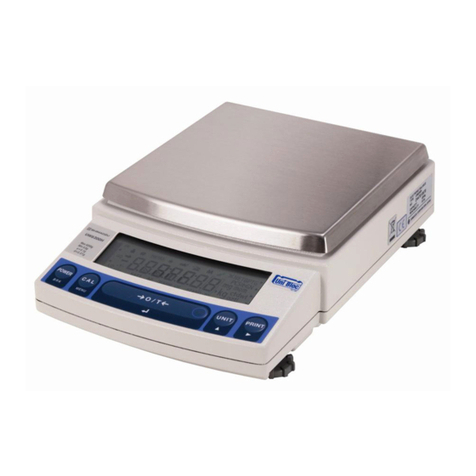
Shimadzu
Shimadzu UW620HV User manual
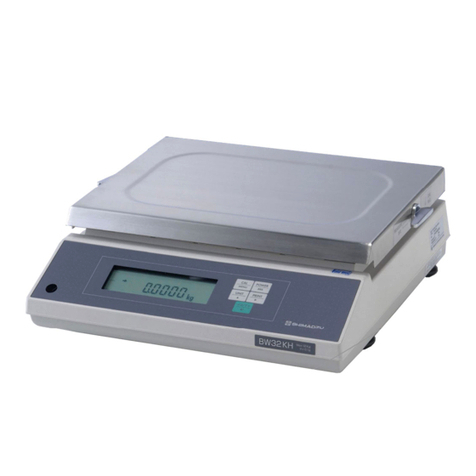
Shimadzu
Shimadzu BX32KS User manual
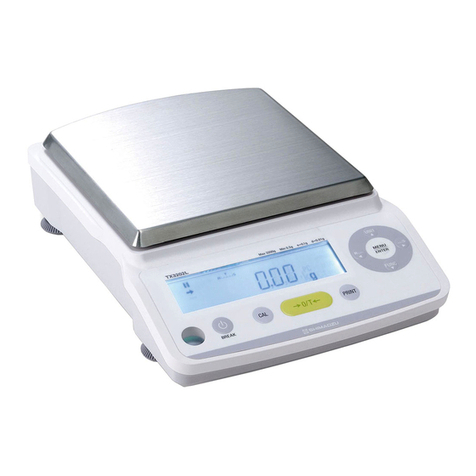
Shimadzu
Shimadzu TW Series User manual
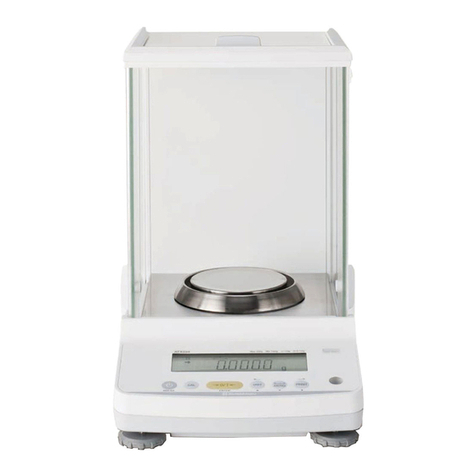
Shimadzu
Shimadzu ATX224 User manual

Shimadzu
Shimadzu ATX224 User manual
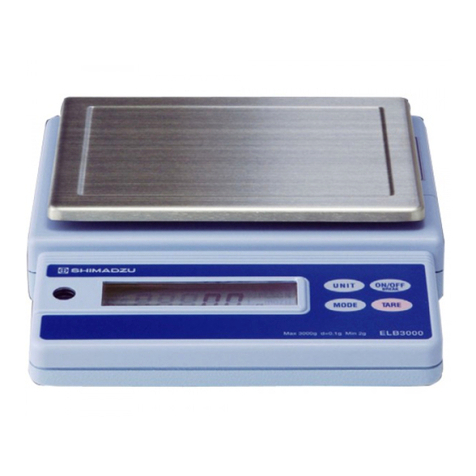
Shimadzu
Shimadzu ELB120 User manual

Shimadzu
Shimadzu AW Series User manual
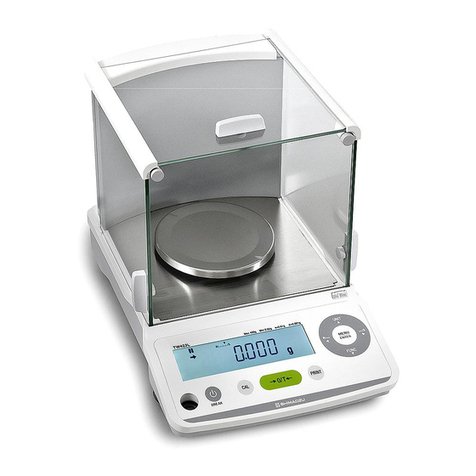
Shimadzu
Shimadzu TW223L User manual
